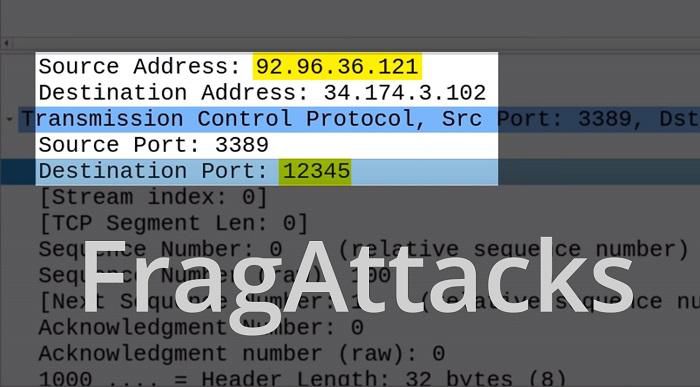Wi-Fi Vulnerability Leads to FragAttacks Attacks
Belgian security researcher Mathy Vanhoef found 12 critical security flaws, which attackers exploited to perform a fragmentation and aggregation attack known as FragAttacks.
Among the errors raised, there are errors that stem from wifi standards dating back to 1997, the rest are common programming errors. Tests show that every wifi product today is affected by at least one vulnerability.

FragAttacks are said to be particularly dangerous because they can allow attackers to gather information about the owner of a Wi-Fi enabled device and run malicious code to compromise the device even with security protocols enabled. WEP or WPA. However, attackers are required to be within range of the device because the FragAttacks attack mechanism cannot be performed remotely.
This is not the first time Vanhoef has found vulnerabilities in wifi devices, he has previously discovered 2 vulnerabilities KRACK and Dragonblood. These two vulnerabilities were reported to the wifi Alliance, which then worked with wifi providers to update these bugs.
Microsoft released updates to patch 3 out of 12 security flaws in March 2021. Several major technology companies such as Cisco Systems, HPE/Aruba Networks, Juniper Networks or Sierra Wireless have published security updates and advice on FragAttacks.
To protect you from FragAttacks, the Wifi Alliance recommends that users of Wi-Fi enabled devices install the latest recommended updates from device manufacturers. Doing this enables suspicious traffic to be detected or improves compliance with recommended security implementations.
You should read it
- What is 51% attack? How does 51% attack work?
- What is a Replay Attack?
- What is Volumetric DDoS Attack?
- What is SS7 attack? What can hackers use it for?
- Analysis of an attack (Part 3)
- What is BlueSmack attack?
- Warning the emergence of ransomware DDoS attack, the scale can be up to 800Gbps
- What is Teardrop attack?
May be interested
- The 4 most popular network attacks towards older people in 2018
 a statistic has shown that in recent years, cyber attacks tend to focus more on older users.
a statistic has shown that in recent years, cyber attacks tend to focus more on older users. - New worm attacks attack dangerous Windows errors
 in the end, a security vulnerability worm that microsoft had blocked with an emergency update 11 days ago appeared on the internet.
in the end, a security vulnerability worm that microsoft had blocked with an emergency update 11 days ago appeared on the internet. - New zero-day vulnerability warning in Windows Search, Windows protocol nightmare getting worse
 a new windows search vulnerability can be exploited to automatically open a search window containing remotely hosted malicious executable files just by launching a word document.
a new windows search vulnerability can be exploited to automatically open a search window containing remotely hosted malicious executable files just by launching a word document. - Protect yourself against IE security holes
 to help you avoid attacks that exploit the newly discovered ie vulnerability, we recommend some tips to help you protect your data safely.
to help you avoid attacks that exploit the newly discovered ie vulnerability, we recommend some tips to help you protect your data safely. - DUHK attacks allow hackers to obtain encryption keys for VPN and web browsing sessions
 duhk - dont use hard-coded keys - is a new dangerous encryption executable vulnerability that allows an attacker to recover the encryption key used to secure vpn connections and web sessions.
duhk - dont use hard-coded keys - is a new dangerous encryption executable vulnerability that allows an attacker to recover the encryption key used to secure vpn connections and web sessions. - Microsoft urgently patched zero-day vulnerability after 2 years of refusing to acknowledge it
 microsoft has just released security updates to fix a high-severity zero-day vulnerability in windows.
microsoft has just released security updates to fix a high-severity zero-day vulnerability in windows. - NVIDIA Jetson chipset contains a series of security holes that allow data theft, DDoS attacks
 a series of new critical security vulnerabilities have been found in the jetson chip framework (nvidia) that could affect millions of active graphics cards worldwide.
a series of new critical security vulnerabilities have been found in the jetson chip framework (nvidia) that could affect millions of active graphics cards worldwide. - DNS attacks are costing governments worldwide huge amounts
 government organizations in each country suffer an average of 12 dns attacks per year.
government organizations in each country suffer an average of 12 dns attacks per year. - This critical vulnerability turns home devices into attack tools
 vulnerabilities in millions of iot devices could allow attackers to view live camera feeds, create botnets, or use the attacked device as a springboard for further attacks.
vulnerabilities in millions of iot devices could allow attackers to view live camera feeds, create botnets, or use the attacked device as a springboard for further attacks. - The security feature prevents the Specter vulnerability, which makes Chrome account for 10-13% more computer RAM
 site isolation is a security feature that separates the layout of individual web pages in order to limit this web attack to the other web. this feature will be turned on by default for most chrome users on win, mac, linux and chrome os to protect computers from attacks through the specter vulnerability.
site isolation is a security feature that separates the layout of individual web pages in order to limit this web attack to the other web. this feature will be turned on by default for most chrome users on win, mac, linux and chrome os to protect computers from attacks through the specter vulnerability.










 Detected critical zero-day vulnerability on Adobe Reader
Detected critical zero-day vulnerability on Adobe Reader All Wifi Devices Can Be Attacked by FragAttacks Vulnerabilities
All Wifi Devices Can Be Attacked by FragAttacks Vulnerabilities Kaspersky discovered many fraudulent websites that took advantage of the Covid-19 vaccine
Kaspersky discovered many fraudulent websites that took advantage of the Covid-19 vaccine Warning: Panda Stealer malware is stealing your cryptocurrency
Warning: Panda Stealer malware is stealing your cryptocurrency The XcodeGhost malware spread to millions of iPhones
The XcodeGhost malware spread to millions of iPhones Belgium suffered an unprecedented DDoS attack
Belgium suffered an unprecedented DDoS attack